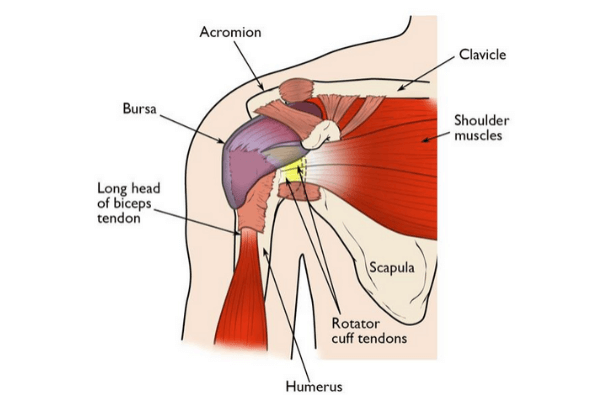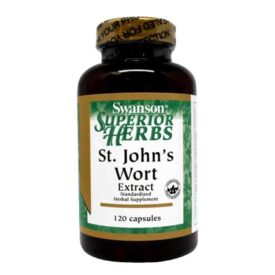Damaging your Rotator Cuff can be one of the most painful and inconvenient injuries around. Typically, most mild pains will go away over time. That may be the case, but damaging a Rotator Cuff could spell some bad news for movement, muscles and tendons.
What Is A Rotator Cuff?

Physiopedia says Your Rotator Cuff is made up of four muscles and tendons which helps you keep your shoulder stable and enable you to move your arm in any way you would like. The four muscles that make up the rotator cuff are the ‘supraspinatus muscle’, ‘infraspinatus muscle’, ‘teres minor muscle’ & ‘subscapularis muscle’.
The group of four muscles and tendons help stabilize the shoulder and aid in movement. Every time you move your shoulder, you are using your rotator cuff to stabilize and help move the joint.
Like most muscle/joint injuries, it can occur during older age due to wear and tear throughout the body. However, it is one of the most common injuries around with strains, tears, bursitis and tendinitis being one of the most common injuries. A shoulder injury is very common and you can read the difference between complete tears of just light damage to the rotator cuff muscles and the shoulder joint.
What Can Cause A Rotator Cuff Injury?

As mentioned above, when you damage your rotator cuff, it can fall into one of three different categories. All in different ranges of shoulder pain and the range of motion which your shoulder blade can do, while you are injured.
When you strain or tear your rotator cuff, this is caused by overuse or an acute injury. Whether it’s from wear and tear or you can overstretch and strain the muscles, or tear the muscles partially or completely. You can also strain or tear your rotator cuff by falling, accidents or other sudden movements which result in pretty immediate and moderate pain.
Goalkeepers and Tennis players are at risk of this because of their dependency on stretching their arms and shoulders in their roles. Seek immediate medical attention for rotator cuff tears.
Bursitis’ are fluid-filled sacs that sit between your rotator cuff tendons and the bone in and around the tendon. Bursitis is caused by inflammation of the bursa and is another common rotator cuff injury.
Tendinitis is rotator cuff injuries which are caused by excessive overuse, thus leading it to become inflamed. People who constantly heave overhead motions with their arms are at most risk of developing this injury, such as painters.
Rotator Cuff Injury Symptoms
Typically, rotator cuff injuries carry a tremendous amount of pain. These can include:
- Avoiding certain activities because of pain or the fear of pain
- Losing the full range of movement within the shoulder
- Difficulty sleeping on the injured cuff,
- When reaching overhead, your shoulder is in pain
- General shoulder pain, which can worsen at night
- Your affected shoulder progressively getting weaker
Whilst these are general & common injuries which you should seek advice straight away. They can be attributed to years of wear and tear on the shoulder cuff which means you could have a damaged shoulder cuff for months or years in advance before you display any symptoms.
Should I See A Doctor About My Rotator Cuff Injury?
Depending on the severity of the pain, you should see a physio or a doctor after about a week. However, if the pain is unbearable, consult medical advice immediately.
As our shoulders rotating are a huge part of our lives, doctors take it very seriously. After looking at your medical injury history, they will give you a physical examination and different types of scans to diagnose the injuries. They do this because they are determining whether your injury has a higher risk for a degenerative condition.
While you’re at the doctor’s, they will also check the range of motion and the strength of your arm/shoulder. This is because they can then check the severity of the injury and rule out other injuries you may have picked up, such as a pinched nerve.
When using scans, the doctors can use them to identify any small bone spurs/growths rubbing against your rotator cuff, which can be causing the pain and inflammation of your tendon. Magnetic Resonance Imaging (MRI) or Ultrasound scans can also be used to determine whether you have, and to what extent your shoulder is damaged. These scans are good because they can find tears in the muscle and see how big and damaging they are whilst also examining your softer tissues in the body.
Rotator Cuff Injury Treatment

There is no magic sports medicine that can magically fix it, unfortunately – you may be in pain for some time. Treatments for injury to the rotator cuff van vary, from rest to rotator cuff surgery. Typically, around 50% of all rotator cuffs injuries do not require any sort of surgery. If you do, however, we think it’s best you get your medical advice on that from a trained medical professional.
Treatments that don’t require any sort of surgery can take weeks or up until months to heal. Some of the treatments are:
- Applying heat and cold to the affected areas, such as Deep Heat & Ice Packs
- Physical Therapy to restore strength and motion of the shoulder by exercising it
- Steroid injections such as Cortisone which helps limit the inflammation in the affected area
- Using a sling to ensure you can isolate the movement of your arm when pain is at its most
- Using over the counter medicine such as ibuprofen which is a proven anti-inflammatory medication.
Once the pain has subsidised, it’s important to keep the shoulder active and try light exercises to keep it moving, Healthline wrote about some of these exercises which are
- Doorway Stretching
- Side-lying external rotations
- High-to-low rows
- Reverse fly
- Lawnmower pull
How To Protect Against Future Injuries
Rotator Cuff Repair is one of the most antagonising recoveries. Just exercises & stretching is usually good enough to heal and build strength back up. Buying some KT Tape is also a brilliant way to support your muscles in movement.
You should take frequent rest breaks when exercising the shoulder moderately until you strengthen your shoulder back up. Make sure to ask a physio or personal trainer for advice on which exercises and stretches you can do to strengthen the rotator cuff, without putting too much stress on it.
In the case of shoulder pain, icing the affected area can help reduce swelling. Apply an ice-pack covered with cloth for no longer than 10 minutes at a time, ensuring that the muscle can be soothed. These activities can also help prevent re-injury. In the case of a more severe rotator cuff tear, shoulder strength may not improve unless the injury is surgically corrected.



